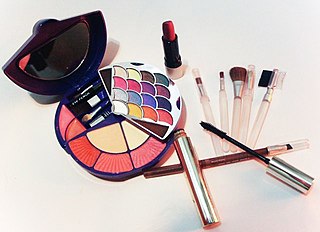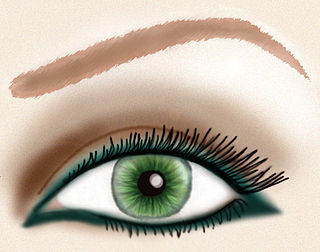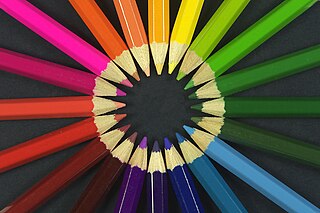
Waxes are a diverse class of organic compounds that are lipophilic, malleable solids near ambient temperatures. They include higher alkanes and lipids, typically with melting points above about 40 °C (104 °F), melting to give low viscosity liquids. Waxes are insoluble in water but soluble in nonpolar organic solvents such as hexane, benzene and chloroform. Natural waxes of different types are produced by plants and animals and occur in petroleum.

Cosmetics are composed of mixtures of chemical compounds derived from either natural sources or synthetically created ones. Cosmetics have various purposes, including personal and skin care. They can also be used to conceal blemishes and enhance natural features. Makeup can also add colour to a person's face, or change the appearance of the face entirely to resemble a different person, creature, or object.

Lip gloss is a cosmetic used primarily to give lips a glossy luster, and sometimes to add a subtle color. It is distributed as a fluid or a soft solid The product is available in ranges of opacity from translucent to solid and can have variously frosted, glittery, glossy, and metallic finishes.

Mascara is a cosmetic commonly used to enhance the upper and lower eyelashes. It is used to darken, thicken, lengthen, and/or define the eyelashes. Normally in one of three forms—liquid, powder, or cream—the modern mascara product has various formulas; however, most contain the same basic components of pigments, oils, waxes, and preservatives. The most common form of mascara is a liquid in a tube with an application brush.

Lip balm or lip salve is a wax-like substance applied typically to the lips to moisturize and relieve chapped or dry lips, angular cheilitis, stomatitis, or cold sores. Lip balm often contains beeswax or carnauba wax, camphor, cetyl alcohol, lanolin, paraffin, and petrolatum, among other ingredients. Some varieties contain dyes, flavor, fragrance, phenol, salicylic acid, and sunscreen.

Lipstick is a cosmetic product used to apply coloration and texture to lips, often made of wax and oil. Different pigments are used to produce color, and minerals such as silica may be used to provide texture. The use of lipstick dates back to early civilizations such as Sumer and the Indus Valley Civilisation, and was popularized in the Western world in the 16th century. Some lipsticks contain traces of toxic materials, such as lead and PFAS, which prompted health concerns and regulation.

Permanent makeup, also known as permanent cosmetics, derma-pigmentation, micro-pigmentation, semi-permanent makeup and cosmetic tattooing, is a cosmetic technique which employs tattoos as a means of producing designs that resemble makeup, such as eye-lining and other permanent enhancing colors to the skin of the face, lips, and eyelids. It is also used to produce artificial eyebrows, particularly in people who have lost them as a consequence of old age, disease, such as alopecia areata, alopecia totalis, chemotherapy, or a genetic disturbance, and to disguise scars and hypopigmentation in the skin such as in vitiligo. It is also used to restore or enhance the breast's areola, such as after breast surgery, or to give an illusion of more hair volume to the scalp.

Eye liner or eyeliner is a cosmetic used to define the eyes. It is applied around the contours of the eye(s). It is often used to create various aesthetic effects.

Eye shadow is a cosmetic applied primarily to the eyelids to attract attention to the wearer's eyes, making them stand out or look more attractive. Eye shadow can also be applied under the eyes, on the cheeks, or to brow bones.

The history of cosmetics spans at least 7,000 years and is present in almost every society on earth. Cosmetic body art is argued to have been the earliest form of a ritual in human culture. The evidence for this comes in the form of utilised red mineral pigments including crayons associated with the emergence of Homo sapiens in Africa. Cosmetics are mentioned in the Old Testament—2 Kings 9:30 where Jezebel painted her eyelids—approximately 840 BC—and the book of Esther describes various beauty treatments as well.

Cosmetics ingredients come from a variety of sources but, unlike the ingredients of food, are often not considered by most consumers. Cosmetics often use vibrant colors that are derived from a wide variety of sources, ranging from crushed insects to rust.

Foundation is a liquid, cream, or powder makeup applied to the face and neck to create an even, uniform color to the complexion, cover flaws and, sometimes, to change the natural skin tone. Some foundations also function as a moisturizer, sunscreen, astringent or base layer for more complex cosmetics. Foundation applied to the body is generally referred to as "body painting" or "body makeup".

Cosmetics in the 1920s were characterized by their use to create a specific look: lips painted in the shape of a Cupid's bow, kohl-rimmed eyes, and bright cheeks brushed with bright red blush.
A cosmetic primer is a cream applied before another cosmetic to improve coverage and lengthen the amount of time the cosmetic lasts on the face.

e.l.f. Beauty, Inc. is an American cosmetics brand based in Oakland, California. It was founded by Joseph Shamah and Scott Vincent Borba in 2004. Items include bath and skin-care products, mineral-based makeup, professional tools, eyeliners, lipstick, glosses, blushes, bronzers, brushes, and mascara, among others.
Lip stain or lip tint, is a cosmetic product used to color the lips, usually in form of a liquid or gel. It generally stays on longer than lipstick by leaving a stain of color on the lips.

A makeup brush is a tool with bristles, used for the application of makeup or face painting. The bristles may be made out of natural or synthetic materials, while the handle is usually made out of plastic or wood. When cosmetics are applied using the appropriate brush, they blend better onto the skin.

A colored pencil, coloured pencil, map pencil, pencil crayon, or coloured/colouring lead is an art medium constructed of a narrow, pigmented core encased in a wooden cylindrical case. Unlike graphite and charcoal pencils, colored pencils' cores are wax- or oil-based and contain varying proportions of pigments, additives, and binding agents. Water-soluble (watercolor) pencils and pastel pencils are also manufactured as well as colored cores for mechanical pencils.

NYX Professional Makeup is an American cosmetics company that is a subsidiary of L'Oréal. The company was founded in Los Angeles by Toni Ko in 1999. It was named after Nyx, the Greek goddess of the night. NYX Professional Makeup is "certified" and acknowledged by PETA as a cruelty-free brand, and they offer a wide range of vegan-friendly products. NYX products are sold in over 70 countries at thousands of retailers, ranging from specialty beauty and fashion stores to freestanding shops and the brand's corporate website.
Male cosmetics include all cosmetic products marketed towards men, such as makeup, skincare products, hair care products, body care products, sun care products, perfumes, and other decorative cosmetics.
















